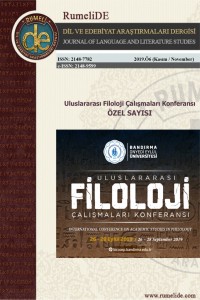Abstract
The Red-Haired Woman (2016) by Orhan Pamuk mirrors the east-west dichotomy by father-son relationship. The author integrates the narratives of King Oedipus and Rostam and Sohrab in the nucleus of the text and the protagonist’s experiences; thereby, he not only brings a dual approach to the question of becoming an individual but manifests the inevitability of fate via myths turning into reality. Pamuk's literary modus operandi in the novel lets coincidence find a palpable meaning and become the repetition of past incidents. Carl Gustav Jung’s concepts of collective unconscious and archetype, in this respect, shed considerable light on the ways in which Pamuk’s characters are led by some collectively shared entities. According to Jung, every individual possesses some reflexes, tendencies and instincts shared by all humanity and stored in the very depth of human mind. Jung argues that collective unconscious, being of primitive and universal quality, appears in dreams and myths and latently influences the way man thinks and behaves. Cem Çelik, the protagonist of The Red-Haired Woman, acts so as to exhibit this holistic influence particularly in terms of father-son relationship; to a great extent, his experiences are presented as recurrences of historical/mythical situations and occurrences that have been repeated throughout human history with cultural changes and manifested in myths. Hence, this paper aims to elucidate Pamuk’s use of myths and discourses of patricide/filicide in The Red-Haired Woman through Jungian perspective.
References
- Davis, Douglas A. (2008). Freud, Jung, and psychoanalysis. The Cambridge Companion to Jung. 39-56. NY: Cambridge University Press. Freud, Sigmund. (2003). Psychopathology of Everyday Life. Translated by A. A. Brill. NY: Dover Publications. Jones, J. Freudian Slips and Mistakes: Definition and Examples. Accessed on 14 June 2019 http://www.freudfile.org/psychoanalysis/freudian_slips.html Jung, Carl Gustav. (2014a). C. G. Jung The Collected Works Volume Nine, Part I: The Archetypes and The Collective Unconscious. [E-Pub]. Translated by R.F.C. Hull. NY: Routledge. Jung, Carl Gustav. (2014b). The Collected Works of C. G. Jung, Volume Eight: Structure & Dynamics of the Psyche. [E-Pub]. Translated by R.F.C. Hull, Princeton, NJ: Princeton University Press. Jung, Carl Gustav. (2014c). The Collected Works of C. G. Jung, Volume Ten: Civilization in Transition. [E-Pub]. Translated by R.F.C. Hull, Princeton, NJ: Princeton University Press. Jung, Carl Gustav. (2015). C. G. Jung Letters: Volume I 1906-1950. Edited by Gerhard Adler. NY: Routledge. Pamuk, Orhan. (2017a) The Red-Haired Woman. [E-Pub version]. NY: Alfred A. Knopf. Pamuk, Orhan. (2017b). I Don’t Write My Books to Explain My Country to Others. Interview with Orhan Pamuk by Isaac Chotiner. August 18, 2017. Accessed on August 25, 2019. https://slate.com/news-and-politics/2017/08/orhan-pamuk-on-writing-about-turkey-his-work-process-and-his-daily-swim.html Pamuk, Orhan. (2016 ). “Orhan Pamuk: Bizi terk eden bir babayla büyüdüm.” [Orhan Pamuk: I grew up with a father who abandoned us]. Interview by Çınar Oskay, 30.01.2016, Hürriyet Kelebek. Accessed on 18 May 2019. http://www.hurriyet.com.tr/kelebek/hayat/orhan-pamuk-bizi-terk-eden-bir-babayla-buyudum-40047198 Thasneem, O. Umer. (2019). Orhan Pamuk and the Poetics of Fiction. Newcastle upon Tyne: Cambridge Scholars Publishing.
Abstract
Orhan Pamuk’un Kırmızı Saçlı Kadın (2016) adlı romanı, doğu-batı
ayrımına baba-oğul ilişkisi üzerinden ayna tutar. Yazar, Sofokles’in Kral Oidipus ve Firdevsi’nin Rüstem ile Sührâb anlatılarını, romandaki
olay akışının ve ana karakter psikolojisinin temeline oturtarak, bir yandan
özgün birey olma tartışmasına çift yönlü bakış açısıyla yaklaşır; diğer
taraftan ise kaderin kaçınılmazlığı görüşünü, gerçeğe dönüşen efsanelerle
yansıtır. Rastlantının, geçmişte karşılık bularak anlam kazandığı, tekrara
dönüştüğü ve romanın ana karakteri Cem Çelik’in duygularını, düşüncelerini ve
davranış biçimini etkilediği bu bakış açısı, Carl Gustav Jung’un, analitik
psikoloji kapsamında ortaya attığı kolektif bilinç dışı ve arketip kavramları
ile açıklanabilir. Jung’a göre her birey, tüm insanlık tarafından paylaşılan ve
zihnin kolektif bilinç dışı alanında yer alan reflekslere, eğilimlere ve
içgüdülere sahiptir. Jung, kolektif bilinç dışının ilkel ve evrensel nitelikte
olduğunu, kendini rüyalarda ve efsanelerde arketiplerle gösterdiğini ve istem
dışı şekilde bireyin davranış ve düşünce sistemini etkilediğini ileri sürer. Kırmızı Saçlı Kadın’da Cem’in baba-oğul
ilişkisi bağlamında hissettikleri, düşündükleri ve aldığı kararlar kolektif
bilinç dışının bir yansımasıdır. Cem’in başından geçenler, ilkel şekliyle
hissettiği aşk ve kıskançlık gibi duygular, insanlık tarihi boyunca, kültürel
değişiklikler geçirerek tekrarlanmış, Kral
Oidipus ve Rüstem ile Sührâb gibi
eserlerde açığa çıkmış tecrübeler olarak sunulur. Bu nedenle, bu çalışma, Kırmızı Saçlı Kadın’daki olay örgüsünü
ve karakter psikolojisini, Jung’un görüşleri ile açıklamayı amaçlamaktadır.
References
- Davis, Douglas A. (2008). Freud, Jung, and psychoanalysis. The Cambridge Companion to Jung. 39-56. NY: Cambridge University Press. Freud, Sigmund. (2003). Psychopathology of Everyday Life. Translated by A. A. Brill. NY: Dover Publications. Jones, J. Freudian Slips and Mistakes: Definition and Examples. Accessed on 14 June 2019 http://www.freudfile.org/psychoanalysis/freudian_slips.html Jung, Carl Gustav. (2014a). C. G. Jung The Collected Works Volume Nine, Part I: The Archetypes and The Collective Unconscious. [E-Pub]. Translated by R.F.C. Hull. NY: Routledge. Jung, Carl Gustav. (2014b). The Collected Works of C. G. Jung, Volume Eight: Structure & Dynamics of the Psyche. [E-Pub]. Translated by R.F.C. Hull, Princeton, NJ: Princeton University Press. Jung, Carl Gustav. (2014c). The Collected Works of C. G. Jung, Volume Ten: Civilization in Transition. [E-Pub]. Translated by R.F.C. Hull, Princeton, NJ: Princeton University Press. Jung, Carl Gustav. (2015). C. G. Jung Letters: Volume I 1906-1950. Edited by Gerhard Adler. NY: Routledge. Pamuk, Orhan. (2017a) The Red-Haired Woman. [E-Pub version]. NY: Alfred A. Knopf. Pamuk, Orhan. (2017b). I Don’t Write My Books to Explain My Country to Others. Interview with Orhan Pamuk by Isaac Chotiner. August 18, 2017. Accessed on August 25, 2019. https://slate.com/news-and-politics/2017/08/orhan-pamuk-on-writing-about-turkey-his-work-process-and-his-daily-swim.html Pamuk, Orhan. (2016 ). “Orhan Pamuk: Bizi terk eden bir babayla büyüdüm.” [Orhan Pamuk: I grew up with a father who abandoned us]. Interview by Çınar Oskay, 30.01.2016, Hürriyet Kelebek. Accessed on 18 May 2019. http://www.hurriyet.com.tr/kelebek/hayat/orhan-pamuk-bizi-terk-eden-bir-babayla-buyudum-40047198 Thasneem, O. Umer. (2019). Orhan Pamuk and the Poetics of Fiction. Newcastle upon Tyne: Cambridge Scholars Publishing.
Details
| Primary Language | English |
|---|---|
| Subjects | Creative Arts and Writing |
| Journal Section | Turkish language, culture and literature |
| Authors | |
| Publication Date | November 21, 2019 |
| Published in Issue | Year 2019 RumeliDE 2019.Ö6 - Bandırma Onyedi Eylül Üniversitesi Uluslararası Filoloji Çalışmaları Konferansı |


